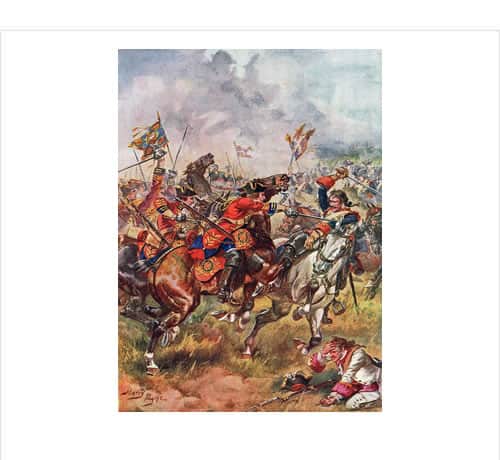Dettingen
It commemorates the last battle in which a King of England was present in person, the last in which the Order of Knighthood was conferred on the field. The actual command was in the hands of the veteran Earl of Stair, a soldier who had learned the art of war under Marlborough. He had commanded a brigade at Ramillies and served on the great commander’s staff at Blenheim, Oudenarde, and Malplaquet.
The Honour is borne on the Guidon of the 3rd Hussars.
Detail
From 1715 until 1742, The King’s Own Regiment of Dragoons soldiered at home, engaging in nothing more exciting than anti-smuggling duty. The uneasy peace in Europe was broken when the Emperor of Austria died and “The War of Austrian Succession” broke out with Britain and Austria once again fighting France.
On 8th June 1743, King George II, the King of England, joined the army, amid a flurry of celebrations and salutes. He brought with him a considerable retinue, conveyed by a long column of carriages and some 600 horses that paralysed the local roads for days, and his younger and favourite son, William Augustus, Duke of Cumberland, a major general in the British Army.
This time there was one major battle and one clear result. King George II led his army into battle on 27 June 1743, near the village of Dettingen where The King’s Own Dragoons endured three hellish hours exposed to French artillery then charged three times through nine squadrons of the French Household Cavalry and routed them.
The British Army had not been in a major continental war for twenty-five years. There were few officers or soldiers with significant fighting experience, other than some older officers who had fought with Marlborough, such as the Earl of Stair and, curiously, King George II himself who had fought with distinction leading the Hanoverian contingent at the Battle of Oudenarde in 1708.
At Dettingen all the officers of The King’s Own Dragoons save two were wounded among the 148 killed or wounded. When George II inspected the Regiment before it returned to England, he sharply asked whose Regiment it was because of the thin ranks, forcing General Bland to answer;
“Please, your Majesty, it is my Regiment, and I believe the remainder of it is at Dettingen”
During the attack by the French Maison du Roi, Cornet Richardson of Ligonier’s Horse (7th Dragoon Guards) rescued his regiment’s standard.
Dragoon Thomas Brown rescued the Guidon of Bland’s Dragoons (3rd Hussars) and was knighted by King George II.
He had an eventful battle, first having two horses killed under him, then getting into a melee over a fallen regimental Guidon in which he had two fingers of his bridle hand cut off.
He returned to the fray and recaptured the flag, but in the process received eight cuts and two musket balls.
He retired from the army, was given a pension and bought a pub in his native Kirkleatham ( N.Yorks ) but only survived for three years, dying as a result of his wounds


